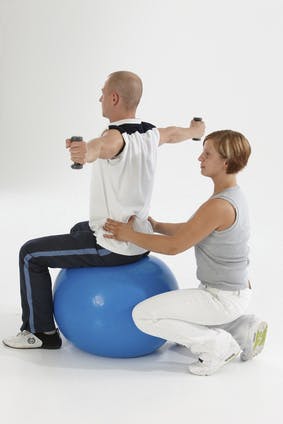Help for Lupus Patients
Physical therapy is an important part of treating the symptoms of lupus. It offers an effective way of dealing with the disease that has multiple benefits that include:

- Pain relief
- Reduced inflammation
- Improved mobility
- Restores physical functionality
- Strengthens bones, tendons and ligaments
- Maintains cardiac function
- Prevents weight gain
- Improves sleep
- Limits or prevents permanent disability
The physical therapist will test and measure a variety of functions before developing a customized treatment plan. He/she will examine motor function and range of motion, strength and muscle performance, respiration and posture, along with balance, coordination and endurance.
Physical Therapy for Patients with Lupus
Lupus is a chronic autoimmune disease marked by inflammation in which the immune system attacks healthy tissue, along with bacteria and viruses. It affects all parts of the body, including skin, joints and organs. People with lupus go through cycles of remission and flare-ups in which symptoms worsen.
The disease is most often seen in women, but men and children can also have the condition. It's not contagious, but it does make individuals more susceptible to illnesses and infections. People can have lupus for a significant length of time without knowing and diagnosing the disease is difficult as it mimics other conditions.
Lupus affects all areas of the body, but takes a particular toll on the brain and central nervous system, blood vessels and blood, lungs, heart and kidneys. One early symptom for some patients is a "butterfly" rash that appears across the cheeks. No two cases act the same, but all patients report joint stiffness, swelling and pain.
Skin lesions may appear, along with headaches, confusion and memory loss. Chest pain, dry eyes and shortness of breath, along with fever and fatigue are common. Lupus patients experience whitening or bluing of the fingers and toes when they're exposed to cold temperatures and during stressful periods in their life.
There's no cure for lupus and some people seem to have a predisposition for developing the disease. The onset of the disease and symptoms thereafter can be triggered by a diverse range of factors ranging from medication to sunlight.
A Holistic Approach To Lupus

Your physical therapy will have a holistic approach to mitigate the symptoms of your disease and work toward the prevention of disability. A specialized exercise program will be developed that speaks to your level of function, mobility, pain and fitness level.
Multiple methods are available that may include clinical Pilates, yoga and manual manipulation if you have difficulty participating in exercise on your own. Ultrasound and electrical stimulation may be employed to reduce swelling and relieve pain.
Aqua therapy is particularly beneficial and soothing for lupus. Water buoys the body, allowing you to move easier and with less resistance from gravity and weight. You'll feel approximately one-third lighter than your actual weight when supported by water, which can act as a form of mild resistance and endurance training for sore, painful and inflamed joints.
Therapeutic massage has a range of benefits for your lupus symptoms. It improves circulation, helps detoxify the body, and relieves pain. It's effective for relieving the stress of living with a chronic disease, while enhancing flexibility, range of motion and mobility.
The exercise program will help you feel less fatigued and improve the functioning of blood vessels. If your lupus symptoms are severe, your physical therapist can help with assistive aids for mobility ranging from canes and crutches to walkers, wheelchairs and motorized conveyances.
Your physical therapist has a wide array of therapies and treatments to ease your pain and address the many symptoms of lupus. Physical therapy provides a path to less pain, better mobility, and improved quality of life.


